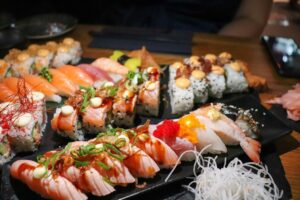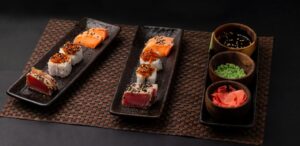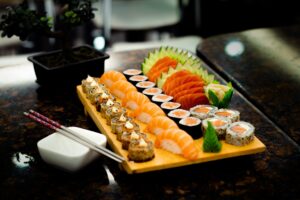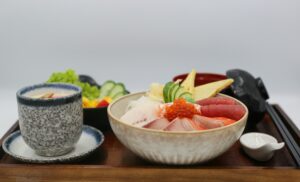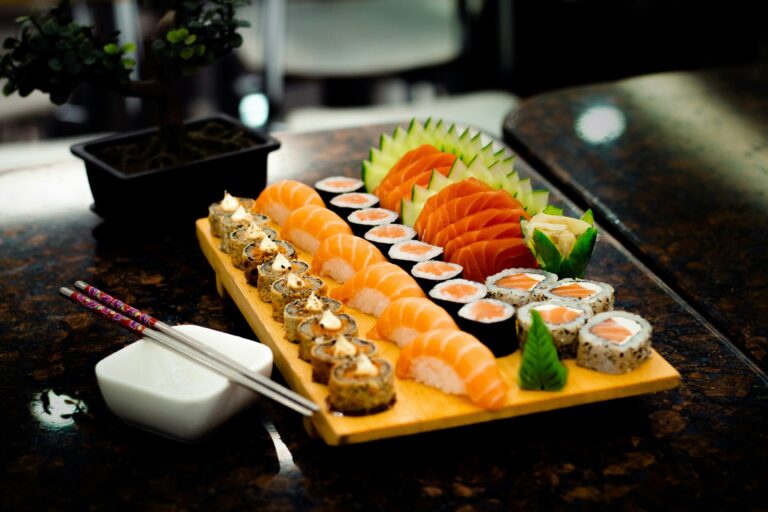
Sushi: The Art and Tradition of Japan’s Most Celebrated Culinary Creation
In the bustling fish markets of Tokyo and the refined dining rooms of the world’s finest restaurants, one dish stands as the ultimate expression of Japanese culinary artistry: sushi. More than just a meal, sushi represents over 1,300 years of culinary evolution, transforming from a simple preservation method into one of the most revered and technically demanding cuisines in the world. The origins of sushi-like fermented fish dishes can be traced across Asia, with broader rice fermentation practices found throughout Southeast Asia, highlighting the region’s significant role in the development of traditional preservation methods.
This ancient art form, which began as a way to preserve fish through fermentation—often utilizing the sun to dry or cure ingredients—has evolved into a sophisticated culinary tradition that demands years of training to master. The influence of China is notable, as many ingredients such as rice and seaweed used in sushi are sourced from China, reflecting the interconnectedness of Asian culinary traditions. From the precise preparation of vinegared rice to the delicate selection of seasonal seafood, every aspect of sushi reflects Japan’s deep respect for ingredients, craftsmanship, and the harmony between tradition and innovation. Japan sushi is renowned for its traditional preparation and diverse regional varieties, such as nigiri, maki, and oshizushi, each with unique characteristics rooted in local culture. In some regional or fusion sushi styles, a thin omelette is used as a wrapping or filling, adding unique flavor and visual appeal to the dish.
Whether you’re planning to visit high-end sushi restaurants in Singapore or simply want to understand the cultural significance behind each piece of nigiri sushi, this comprehensive guide will take you through the essential elements that make sushi one of the world’s most celebrated dishes. Sushi enjoys a global reputation as a famous Japanese dish, with famous regional varieties like funa-zushi and iconic styles that have contributed to its worldwide acclaim. In certain sushi types, such as chirashizushi, ingredients are artfully spread over sushi rice to create visually stunning and flavorful presentations.
What is Sushi: Understanding Japan’s Iconic Dish
At its core, sushi refers to a dish combining vinegared rice with various ingredients, most notably fresh fish and seafood, but also vegetables, eggs, and other components. The term “sushi” actually refers to the seasoned rice itself, not the fish—a common misconception that confuses sushi with sashimi, which consists of sliced raw seafood served without rice.
The historical origins of sushi trace back to the 8th century when it appeared in Japan as narezushi, a preservation method where fish was packed with salt and rice to ferment over several months. During this early period, the rice was typically discarded after fermentation, serving only as a preservation medium. Written records from the Yoro Code of 718 document this early form of sushi as a method for storing fish protein in pre-refrigeration times.
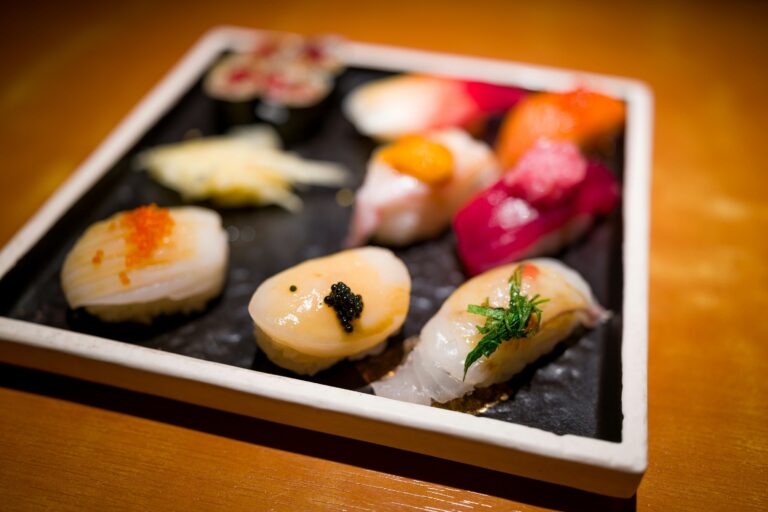
The transformation from preservation technique to culinary art began during the Edo period (1603-1868), when rice vinegar replaced the lengthy fermentation process. This innovation, known as hayazushi or “fast sushi,” dramatically reduced preparation time and improved palatability. The modern nigiri-zushi that most diners recognize today was invented in 1824 by Hanaya Yohei, who began topping small rice balls with fresh slices of fish, creating what would become the foundation of contemporary sushi culture. It is important to note that ‘edomae sushi’ refers to this traditional Tokyo style of sushi preparation, originating during the Edo period and emphasizing craftsmanship and historical techniques.
Sushi chefs must carefully manage ingredient quality, preparation methods, and food safety protocols to maintain the high standards expected in authentic sushi.
When discussing sushi types, note that nigirizushi (hand-pressed sushi), gunkanzushi (battleship sushi), and other forms each have distinct preparation methods and terminology, reflecting the diversity within sushi culture.
This evolution reflects sushi’s role as a cornerstone of Japanese culinary tradition, embodying the country’s principles of seasonal appreciation (shun), technical mastery, and respect for natural ingredients. Modern sushi maintains these traditional values while embracing innovations that make this exquisite dish accessible to diners worldwide.
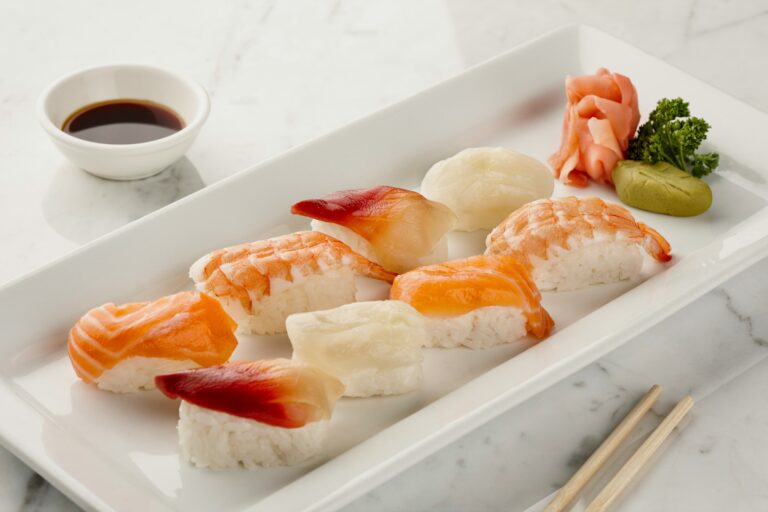
The Seasonal Menu and Essential Components of Authentic Sushi
Sushi Rice (Shari)
The foundation of exceptional sushi lies in perfectly prepared sushi rice, known as shari in Japanese. This isn’t ordinary steamed rice—it’s a carefully crafted base that requires specific short-grain Japanese rice varieties, typically Koshihikari or Sasanishiki, which provide the ideal texture and starch content for sushi preparation.
The preparation process begins with thorough washing, where the rice is rinsed until the water runs clear, removing excess starch that could create a gluey texture. The rice is then cooked using precise water-to-rice ratios, typically around 1.2:1, depending on the rice variety and season. The cooking method involves bringing the rice to a boil, then reducing heat for gentle steaming.
The critical step occurs after cooking, when the hot rice is seasoned with a mixture of rice vinegar, sugar, and salt while being gently folded and cooled to body temperature. This vinegar blend, called sushi-zu, gives the rice its characteristic tangy flavor that complements rather than competes with the fish. Master sushi chefs spend years perfecting this technique, as the rice must maintain individual grain integrity while achieving the proper moisture content and temperature.
Regional variations exist across Japan, with some areas preferring slightly sweeter or more acidic vinegar blends. The finished sushi rice should hold together when formed but separate easily when eaten, creating the perfect foundation for various kinds of sushi preparations.
Fresh Fish and Seafood (Neta)
The quality of fish and seafood, known as neta, determines the excellence of any sushi experience. Premium sushi establishments source their seafood from Tokyo’s renowned Toyosu Market (formerly Tsukiji), where the world’s finest tuna, including the prized fatty tuna varieties, are auctioned daily to discerning chefs and distributors.
Traditional sushi features an array of fish types, each with optimal seasons for peak flavor. Tuna varieties range from the lean akami to the highly prized chu-toro (medium fatty tuna) and o-toro (fatty tuna), with the latter commanding premium prices due to its rich, buttery texture. Other classical options include yellowtail (hamachi), sea bream (tai), mackerel (saba), and various shellfish like uni (sea urchin) and ikura (salmon roe). Abalone is also considered a prized seafood ingredient, especially in traditional and high-end sushi, where its delicate flavor and texture are highly valued. Squid is another popular sushi topping, commonly used in nigiri and other sushi types, appreciated for its subtle taste and versatility in both raw and cooked preparations.
Seasonal considerations play a crucial role in authentic sushi preparation. A traditional seasonal menu might feature different fish throughout the year: spring brings young fish like kohada (young shad), summer offers aji (horse mackerel), autumn provides rich, fatty fish preparing for winter, and winter showcases premium varieties like wild bluefin tuna at their peak fat content.
Many fish undergo traditional aging processes, where they’re cured with salt, marinated in soy sauce, or aged for specific periods to concentrate flavors and achieve optimal texture. These techniques, passed down through generations, demonstrate the technical expertise required to transform fresh seafood into sushi-grade neta.
Supporting Ingredients
Beyond rice and fish, authentic sushi relies on carefully selected supporting ingredients that enhance rather than mask the primary flavors. Nori seaweed, harvested from Japanese coastal waters, provides the wrapper for sushi rolls and adds a subtle oceanic flavor with a satisfying texture contrast.
Wasabi, the fiery green paste served alongside sushi, should ideally be freshly grated from the rhizome of the wasabi plant rather than the horseradish-based substitutes common in many restaurants. True wasabi offers a complex heat that stimulates the nasal passages without overwhelming the palate, cleansing the taste buds between different fish varieties.
Pickled ginger, or gari, serves as a palate cleanser, its mild acidity and subtle sweetness preparing the mouth for the next piece. Quality gari should be pale pink (from natural aging) rather than artificially colored bright pink, with a crisp texture and balanced flavor.
Soy sauce for sushi differs from regular varieties, often being less salty and sometimes aged specifically for seafood pairing. Some high-end establishments prepare custom soy sauce blends or apply sauce directly to the fish, eliminating the need for diners to use additional condiments.
Traditional Types of Sushi
Nigiri Sushi
Nigiri-zushi represents the pinnacle of sushi artistry, consisting of hand-pressed rice topped with fish or seafood. Each piece requires precise technique—the rice must be gently formed to maintain proper density while the fish is carefully draped over the top, often with a small amount of wasabi between the layers.
Classic nigiri varieties include chu-toro (medium fatty tuna), which offers the perfect balance between lean tuna’s clean flavor and fatty tuna’s rich texture. Uni (sea urchin) provides a creamy, oceanic taste that divides diners into devoted fans or skeptics. Ebi (shrimp) is typically cooked and offers a sweet, firm texture that appeals to those new to raw fish preparations.
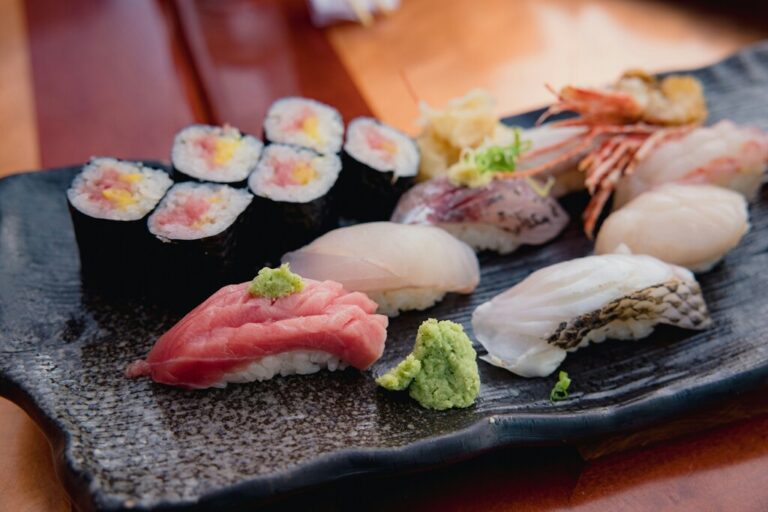
The preparation order in traditional sushi restaurants follows a carefully planned progression from lighter to more robust flavors. Diners typically begin with delicate white fish like sea bream, progress through medium-flavored options like yellowtail, and conclude with rich, fatty fish or strongly flavored varieties like mackerel sushi or unagi (eel).
Proper nigiri technique requires the chef to form each piece individually, ensuring consistent rice portions while accommodating the specific characteristics of each fish type. The rice should be warm enough to slightly soften when eaten, while the fish maintains its optimal temperature and texture.
Maki and Temaki
Makizushi, commonly known as sushi rolls, consists of rice and fillings rolled in nori seaweed using a bamboo mat called a makisu. Traditional varieties include simple preparations like kappa maki (cucumber rolls) and tekka maki (tuna rolls), which showcase the quality of individual ingredients without complex flavor combinations.
Temaki, also known as a hand roll, takes a more casual approach to rolled sushi, shaped into cone-like forms that diners eat immediately after preparation. Hand rolls are especially popular as a made-to-order, portable sushi option, making them a favorite on-the-go snack. These are popular for their portability and the textural contrast between crispy nori and the soft filling. Common temaki fillings include spicy tuna, salmon, and various combinations of fish with vegetables.
Regional variations like Osaka-style pressed sushi (oshizushi) demonstrate the diversity within traditional Japanese preparations. This style uses wooden molds to create uniform, densely packed pieces that often feature mackerel or other local fish specialties, reflecting regional tastes and available seafood.
The size and composition of maki vary significantly—hosomaki (thin rolls) typically contain single ingredients, while futomaki (thick rolls) accommodate multiple components and are often prepared for special occasions or bento box presentations.
Specialty Sushi Forms
Gunkanmaki, or “warship rolls,” address the challenge of serving soft or liquid toppings like ikura (salmon roe) or uni. These pieces feature a strip of nori wrapped around a rice base, creating a vessel that contains delicate ingredients while maintaining structural integrity.
Inari-zushi offers a vegetarian-friendly option featuring sweetened fried tofu pouches filled with seasoned sushi rice. Popular throughout Japan, these pouches (called inari-age) are simmered in a sweet soy-based sauce that complements the vinegared rice perfectly.
Chirashi-don presents deconstructed sushi in bowl form, with various sashimi scattered over a bed of sushi rice. This style allows diners to enjoy multiple fish types in a single serving while appreciating the rice as a substantial base rather than just a vehicle for the fish.
These specialty forms demonstrate sushi’s adaptability to different ingredients and dining situations while maintaining the fundamental principles of rice preparation and ingredient quality that define authentic Japanese cuisine.
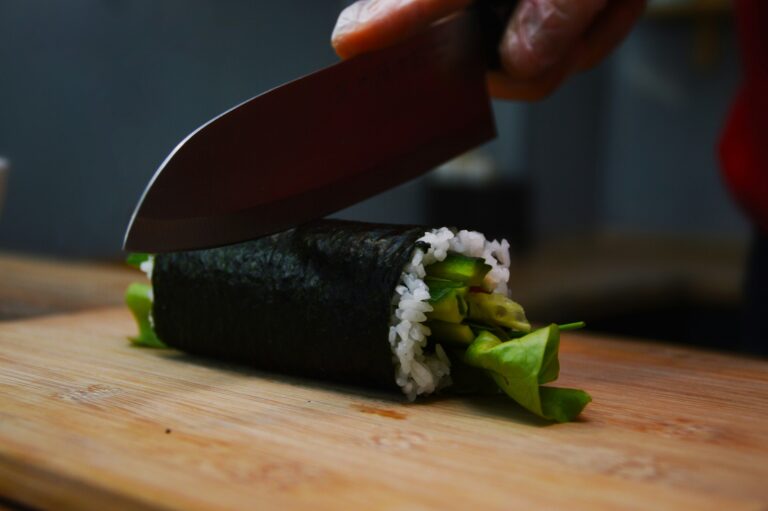
Regional Sushi Variations and Modern Adaptations
Western-Style Sushi Innovation
The globalization of sushi has produced remarkable innovations that maintain core principles while adapting to local tastes and available ingredients. The California roll, created in 1960s-70s Los Angeles, represents one of the most successful adaptations, featuring imitation crab, avocado, and cucumber in an inside-out roll (uramaki) format that appeals to Western palates hesitant about raw fish.
Uramaki, with rice on the outside and nori on the inside, became popular in Western countries partly because it made the seaweed less visually prominent for unfamiliar diners. This style accommodated fusion ingredients like cream cheese, tempura components, and non-traditional vegetables while maintaining the fundamental structure of rolled sushi.
Modern fusion approaches have introduced ingredients like mango, jalapeño, and various sauces that would never appear in traditional Japanese preparations. While purists might question these innovations, they’ve successfully introduced millions of diners to sushi culture, often serving as stepping stones toward appreciation of more traditional preparations.
The key to successful adaptation lies in maintaining quality standards and technical excellence even when using non-traditional ingredients. Restaurants that succeed in this fusion approach typically employ chefs trained in traditional techniques who understand how to balance flavors and textures regardless of the specific ingredients used.
Global Sushi Culture
The introduction of conveyor belt sushi (kaiten-zushi) by Yoshiaki Shiraishi in 1958 revolutionized sushi accessibility, allowing restaurants to serve quality sushi at affordable prices while maintaining food safety standards. This innovation democratized sushi dining in Japan and provided a model for international expansion. Many sushi restaurant brands have since established multiple outlets worldwide, with each outlet often offering unique menu items and experiences tailored to local tastes.
International sushi restaurant standards vary dramatically, from authentic establishments staffed by Japanese-trained chefs to casual spots that prioritize speed and affordability over traditional techniques. The best international sushi restaurants typically maintain connections to Japanese suppliers, train staff in proper techniques, and respect the cultural significance of the cuisine they’re serving.
Sustainable fishing practices have become increasingly important in modern sushi preparation, with conscious consumers and responsible chefs seeking alternatives to overfished species like bluefin tuna. This movement has led to increased appreciation for lesser-known fish varieties and farming techniques that can provide consistent quality while reducing environmental impact.
The cultural significance of sushi in Japanese business and social settings extends beyond mere dining—it represents hospitality, attention to detail, and respect for tradition. Understanding these cultural contexts enhances appreciation for sushi as more than just a meal, but as an expression of Japanese values and aesthetics.
The Art of Sushi Preparation
Traditional Tools and Equipment
Master sushi preparation requires specialized tools that have been refined over centuries of use. The hangiri, a shallow wooden tub made from cypress or cedar, serves as the vessel for mixing sushi rice with vinegar seasoning. The wood’s natural properties help absorb excess moisture while the wide, shallow design facilitates even cooling and mixing.
Shamoji, flat wooden paddles, are essential for handling sushi rice without crushing the grains. These tools allow chefs to fold the vinegar mixture into the rice with cutting motions that prevent the development of starch that would make the rice gummy. The technique requires practice to achieve the proper speed and angle that preserves grain integrity.
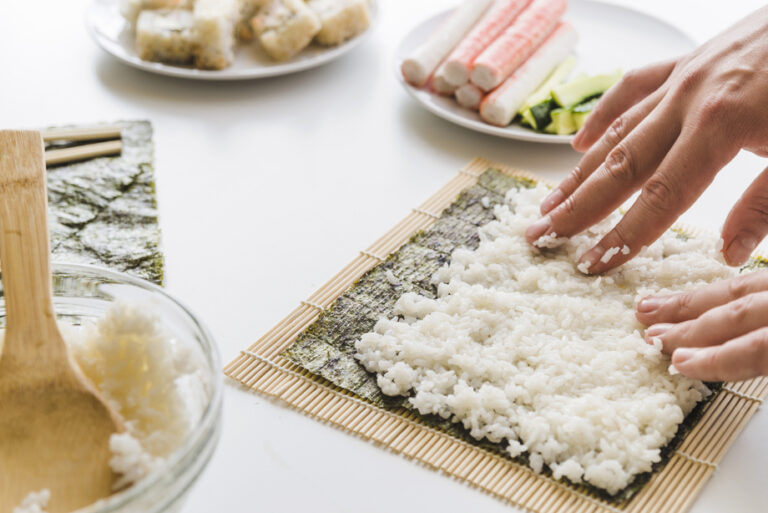
Yanagiba knives, specifically designed for sushi preparation, feature long, thin blades that enable single-stroke cuts through fish. This technique prevents the tearing that would occur with sawing motions, preserving the fish’s texture and appearance. These knives require regular maintenance and sharpening to maintain their effectiveness.
Makisu bamboo mats facilitate the rolling of maki sushi, providing the pressure and support needed to create tight, uniform rolls. The bamboo construction allows for easy cleaning while providing enough flexibility to accommodate different filling volumes and rolling techniques.
Master Chef Training and Techniques
The traditional apprenticeship system for sushi chefs involves years of preparation before students are allowed to handle fish. Apprentices typically spend months or years perfecting rice preparation, learning to achieve consistent texture, temperature, and seasoning that meets their master’s standards.
Knife skills development encompasses not only cutting techniques but also understanding how different angles and pressures affect various fish types. Tuna requires different handling than delicate white fish, and each species has optimal cutting directions that preserve texture and enhance flavor presentation.
Temperature control extends beyond keeping fish cold—sushi rice must be served at body temperature, fish should be slightly below room temperature, and the chef’s hands must be kept at the proper temperature to avoid warming ingredients during preparation. This attention to thermal detail affects both flavor and food safety.
Customer interaction in omakase service represents the highest level of sushi dining, where chefs select and prepare each piece based on the diner’s preferences, the day’s best ingredients, and the optimal progression of flavors. This intimate service style requires chefs to understand not only technical preparation but also customer psychology and timing.

Restaurants That Serve Sushi in Singapore
Singapore’s vibrant dining scene offers exceptional sushi experiences across all price ranges, from casual neighborhood spots to world-class omakase establishments. Many high-end sushi restaurants in Singapore offer exclusive dinner courses, often featuring omakase menus with detailed descriptions and prices for a luxurious evening experience. The location of sushi restaurants in Singapore—often near business districts, shopping centers, and popular neighborhoods—plays a key role in their popularity and accessibility. The city’s position as a major port has historically provided access to premium seafood. Many sushi restaurants also provide a curated selection of sake and other traditional Japanese beverages to complement the meal. Its diverse population has created demand for both traditional and innovative sushi preparations. Many restaurants offer sushi platter options, allowing guests to enjoy a variety of sushi pieces in a single, beautifully presented set.
Budget-Friendly Sushi Restaurants
For diners seeking quality sushi without breaking the bank, several establishments continue to offer excellent value in Singapore. Genki Sushi maintains multiple outlets across the island, featuring conveyor belt service that keeps costs low while maintaining consistent quality standards. Their signature dishes include fresh salmon nigiri and creative rolls that appeal to local tastes.
Sushi Express operates numerous locations throughout Singapore, offering quick service and affordable pricing that makes sushi accessible for casual dining. Their menu focuses on popular varieties like tuna, salmon, and eel, with reliable preparation that satisfies sushi cravings without the premium pricing of high-end establishments.
These budget-friendly restaurants typically source ingredients through established supply chains that ensure food safety while managing costs. While they may not offer the premium cuts found at luxury establishments, they provide an excellent introduction to sushi for newcomers and convenient options for regular diners.
Mid-Range Sushi Restaurants
Singapore’s mid-range sushi restaurants strike an excellent balance between quality and accessibility, often featuring chefs with formal training and more premium ingredient selections. Teppei offers multiple locations with chef-driven preparations that showcase both traditional techniques and local preferences, creating a dining experience that respects Japanese traditions while accommodating Singapore’s diverse palate.
Man Man Japanese Unagi Restaurant specializes in eel preparations alongside traditional sushi offerings, providing guests with expertly grilled unagi and fresh sushi options in an elegant yet approachable setting. Their seasonal menu reflects the best available ingredients while maintaining consistent pricing that appeals to regular diners.
These mid-tier establishments often feature counter seating where diners can observe the preparation process, creating an educational experience that enhances appreciation for the skill involved in sushi making. The chefs at these restaurants typically have several years of training and can accommodate special requests while maintaining quality standards.
High-End Sushi Restaurants
At the pinnacle of Singapore’s sushi scene, several establishments offer world-class omakase experiences comparable to Tokyo’s finest restaurants. Sushi Masa represents the gold standard for authentic Japanese sushi in Singapore, featuring Chef Masa’s decades of experience and unwavering commitment to traditional techniques combined with the finest imported ingredients.
Sushi Masa’s omakase service showcases seasonal selections that change based on the best available fish from Toyosu Market, often featuring rare varieties and premium cuts that demonstrate the chef’s expertise and relationships with top suppliers. The intimate counter setting allows diners to interact directly with Chef Masa, creating a personalized experience that reflects the highest traditions of Japanese hospitality.
Other high-end establishments like Shinji by Kanesaka maintain similar standards, with chefs trained in Japan and ingredient sourcing that rivals the best international sushi restaurants. Some restaurants and chefs in Singapore also specialize in Kyoto-style sushi or incorporate traditional Kyoto culinary techniques and ingredients, offering diners an authentic Kyoto experience. These restaurants require reservations well in advance and command premium prices that reflect their commitment to excellence in every aspect of the dining experience.
The investment in these experiences extends beyond the meal itself—diners gain appreciation for the artistry, tradition, and technical skill that define authentic sushi culture while enjoying ingredients and preparations that represent the absolute pinnacle of the cuisine.
Proper Sushi Dining Etiquette and Appreciation
Understanding proper sushi dining etiquette enhances both the experience and the appreciation of the chef’s artistry. Traditional eating methods vary depending on the type of sushi being served—nigiri is often eaten by hand, allowing diners to maintain the proper orientation and temperature, while maki and other rolled varieties are typically consumed with chopsticks.
The correct use of wasabi and soy sauce requires restraint and understanding. Rather than mixing wasabi into soy sauce, diners should apply small amounts directly to the fish or allow the chef to apply the appropriate amount during preparation. Excessive soy sauce can overwhelm delicate fish flavors and is considered disrespectful to the chef’s seasoning choices.
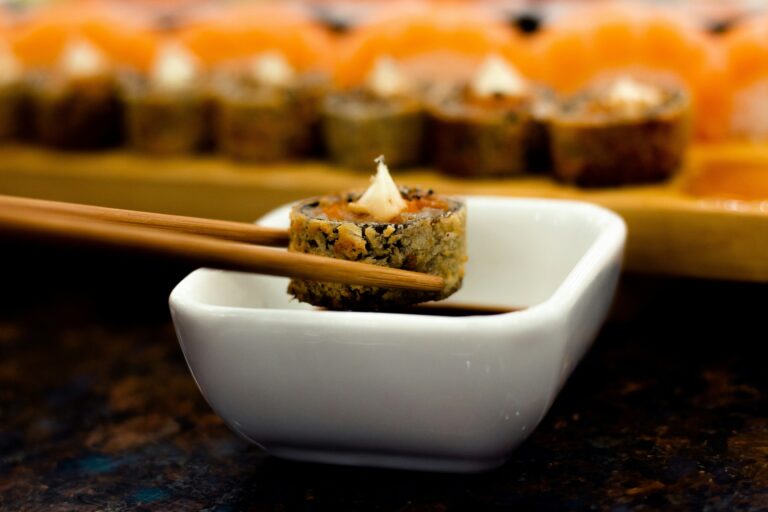
Optimal eating order progresses from lighter to heavier flavored fish, typically beginning with delicate white fish and progressing through medium-flavored varieties to rich, fatty fish. This progression allows diners to appreciate subtle flavor differences without overwhelming their palate early in the meal.
Appreciation of seasonal ingredients and chef recommendations demonstrates respect for the expertise and preparation that goes into each piece. Asking questions about the fish’s origin, preparation method, or optimal eating technique shows genuine interest and often leads to enhanced service and recommendations.
In authentic Japanese sushi establishments, tipping is not customary and can even be considered offensive. Instead, expressing genuine appreciation for the meal and the chef’s skill through words and demeanor provides the most appropriate recognition for exceptional service.
Sushi’s Cultural Impact and Future
The UNESCO recognition of washoku (Japanese cuisine) including sushi as Intangible Cultural Heritage in 2013 acknowledges the cultural significance that extends far beyond mere sustenance. This recognition emphasizes sushi’s role in preserving traditional techniques, seasonal appreciation, and the harmony between humans and nature that characterizes Japanese culinary philosophy.
The economic impact of the sushi industry on Japanese fishing communities and exports reaches billions of dollars annually, supporting traditional fishing methods while driving innovation in aquaculture and sustainable seafood production. Premium ingredients like bluefin tuna can command prices exceeding three million dollars for exceptional specimens, highlighting the luxury market’s continued appreciation for quality.
Sustainability challenges facing the sushi industry have sparked innovative solutions ranging from aquaculture advances to plant-based alternatives that replicate traditional textures and flavors. Forward-thinking restaurants are exploring lab-grown fish, alternative proteins, and sustainable sourcing practices that preserve the essence of sushi while addressing environmental concerns.
Technology integration in sushi restaurants increasingly includes automated rice preparation systems, digital ordering platforms, and supply chain tracking that ensures ingredient freshness and authenticity. However, the core artistry of sushi preparation remains fundamentally human, requiring the intuition, skill, and cultural understanding that cannot be replicated by machines.
The next generation of sushi chefs faces the challenge of balancing tradition with contemporary culinary innovation, often training in both classical Japanese techniques and modern culinary methods. This evolution ensures that sushi will continue to adapt and thrive while maintaining the fundamental principles that have made it one of the world’s most respected cuisines. Many modern sushi restaurants now offer a dessert menu, featuring sweet dishes like burnt cheesecake and tiramisu, to complement the sushi dining experience and appeal to a wider range of diners.
As sushi continues to evolve globally, its success lies in maintaining the delicate balance between accessibility and authenticity, innovation and tradition. Whether experienced at a casual conveyor belt restaurant or a premium omakase counter, sushi remains a testament to the transformative power of culinary artistry, cultural tradition, and the endless pursuit of perfection that defines the best of Japanese cuisine.
From its humble origins as a fish preservation method to its current status as a global culinary phenomenon, sushi represents more than just a dish, it embodies a philosophy of respect for ingredients, mastery of technique, and appreciation for the subtle harmonies that create extraordinary dining experiences. For those seeking to understand this remarkable cuisine, whether through dining at Singapore’s exceptional sushi restaurants or simply appreciating the artistry involved, sushi offers a window into the rich cultural traditions that continue to influence culinary excellence worldwide.

